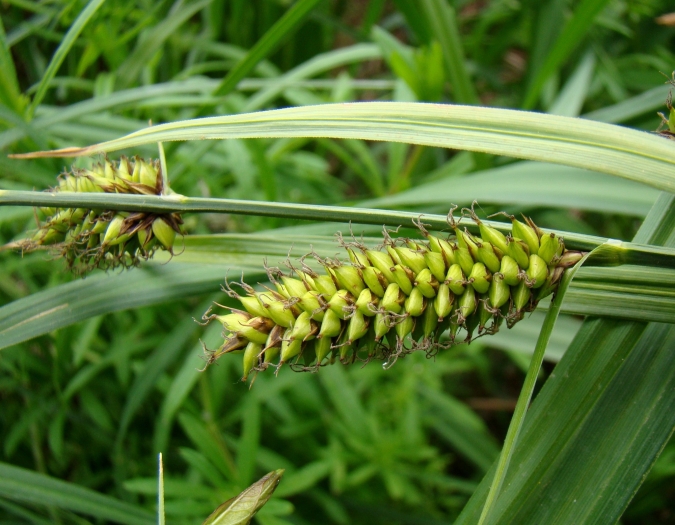Greater Pond Sedge
(Carex riparia)
Greater Pond Sedge (Carex riparia)
/
/

Юрий Данилевский (Yuriy Danilevsky)
CC BY 4.0
Image By:
Юрий Данилевский (Yuriy Danilevsky)
Recorded By:
Copyright:
CC BY 4.0
Copyright Notice:
Photo by: Юрий Данилевский (Yuriy Danilevsky) | License Type: CC BY 4.0 | License URL: http://creativecommons.org/licenses/by/4.0/ | Rights Holder: Юрий Данилевский (Yuriy Danilevsky) | Publisher: iNaturalist | Date Created: 2016-04-24T23:13:08-07:00 |
























Estimated Native Range
Summary
Carex riparia, commonly known as Greater Pond Sedge, is a perennial herbaceous plant native to a wide range of wetland habitats including riverbanks, ditches, fens, marshes, and wet woodlands across Europe and Asia. It is particularly adapted to slowly-flowing rivers and standing water bodies such as lakes and ponds. This sedge can grow up to 4 feet tall, with striking glaucous (bluish-green) leaves that may reach up to 5 feet in length. The inflorescences are not particularly showy, but the dense clumps of foliage provide a lush, textural contrast in water garden settings.
Greater Pond Sedge is valued for its ability to stabilize soil and its use in water purification in constructed wetlands. It is often used in naturalistic plantings, riparian buffer zones, and as an ornamental feature in water gardens. Carex riparia prefers consistently moist to wet soils and can tolerate a range of soil types, from clay to loam. It thrives in full sun to part shade conditions. While generally low-maintenance, it can spread aggressively by rhizomes, potentially becoming invasive outside its native range. Gardeners should be cautious and consult local regulations before planting it in non-native areas.CC BY-SA 4.0
Greater Pond Sedge is valued for its ability to stabilize soil and its use in water purification in constructed wetlands. It is often used in naturalistic plantings, riparian buffer zones, and as an ornamental feature in water gardens. Carex riparia prefers consistently moist to wet soils and can tolerate a range of soil types, from clay to loam. It thrives in full sun to part shade conditions. While generally low-maintenance, it can spread aggressively by rhizomes, potentially becoming invasive outside its native range. Gardeners should be cautious and consult local regulations before planting it in non-native areas.CC BY-SA 4.0
Plant Description
- Plant Type: Grass
- Height: 3-6 feet
- Width: 2-3 feet
- Growth Rate: Moderate
- Flower Color: N/A
- Flowering Season: Spring
- Leaf Retention: Deciduous
Growth Requirements
- Sun: Full Sun, Part Shade
- Water: High
- Drainage: Slow, Standing
Common Uses
Erosion Control, Low Maintenance, Water Garden
Natural Habitat
Native to riverbanks, ditches, fens, marshes, and wet woodlands across Europe and Asia
Other Names
Common Names: Riparian Sedge, Large-fruit Sedge
Scientific Names: , Carex riparia, Carex acuta, Carex acuta subsp. ruffa, Carex acuta var. sennenii, Carex acuta var. sennenii, Carex bifurca, Carex crassa, Carex exaltata, Carex gracilescens
GBIF Accepted Name: